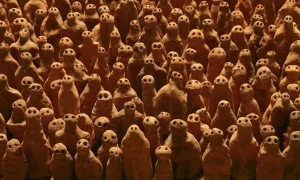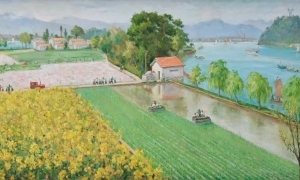我曾在上世纪90年代初的一篇文章中断言:走向抽象,是水墨画发展的一个必然趋势。理由是,从形态演进的角度看,水墨画的产生即标志了传统绘画从具象向意象、从写实向写意的一次飞跃。水墨画在其发展的早期,就已带有浓重的抽象意味。《唐朝名画录》曾记载王洽作画常在“醺酣之后,即以墨泼,或笑或吟,脚蹙手抹,或挥或扫,或淡或浓,随其形状,为山为石,为云为水,应手随意,倏若造化,图出云霞,染成风雨,宛若神巧,俯观不见其墨污之迹”。王洽对泼墨“随其形状”的偶然性把握,其实就是以抽象手法为先导的一种意象创造活动。但由于这种画法过分地超前,不为当时的史家所重,认为其“非画之本法”(《唐朝名画录》),张彦远甚至认为“山水家有泼墨,亦不谓之画”,因而“不堪仿效”。但这种近于抽象的画法所具有的诱惑力却随着水墨性能的愈益发挥而有增无减。进入近现代,随着西方抽象主义的勃兴,这一潜在因素更得到进一步张扬,由泼墨而进于泼彩,如张大干、刘海粟所作的那样。不过,在他们的画中,“抽象”仅止于一种手法的借用,还构不成真正的抽象主义。抽象主义在水墨领域中的兴起,首见于台湾六十年代初出现的现代艺术运动。以刘国松为代表的一批画家率先开启了抽象水墨的新画风。进入八、九十年代,抽象水墨又继起于大陆,虽然尚未酿成大的气候,但作为水墨画演进中的一个新形态,已是无可质疑地出现了。
从语言层面看,抽象水墨大体缘自三个方面:一是从笔法中演展,如黄宾虹所提示的那样,以笔法消解形象,以笔韵自身的价值取代形象的价值;二是从墨法中演展,从破墨、泼墨、泼彩到各种肌理、肌质的创造。使水性、墨性、纸性得以淋漓尽致地发挥,从水与墨的自然渗化中把握一种抽象神韵,如刘国松所提示的那样;三是从水墨的点、线、面的综合构成中演展,在这里“水墨”只是作为材料被借用,即使强调笔墨,笔墨本身也不能成为视觉中心,而只有这些元素和它们的构成关系才是画面的主宰,“构成”以其自身的张力展示一定的精神内涵,如吴冠中90年代的抽象作品中所展示的那样。到90年代中期以后,在“实验水墨”的旗号下结集的一批水墨画家始构成了一个向抽象领域迈进的阵势。此外,书法界的前卫派也正在以扬弃“字音”、“字义”及解构“字型”的方式向抽象水墨靠拢,从而在笔墨运行中建立起一种新的空间秩序,从“书画同源”走向“书画同归”。
进入21世纪,抽象水墨的最新进展应以纯粹的语言状态为标志,李华生、梁铨、张羽等,都在纯粹的语言层面展开了他们的探索,他们彻底放弃外在世界的诱惑,在艺术本体语言的建构中获得一种诉求内心的方式。
作为后起之秀,田卫在近年中所作的探索卓有成效。他的突飞猛进,使他的艺术在短短几年中修炼到一种很难得、很纯粹的状态。这种“纯粹状态”既体现在作为艺术作品的语言层面,也体现在作为艺术家的精神层面。当画家将心迹内敛,专注于语言本身的意趣时,墨淡水清中依然痕迹斑斑,心心相印。
记得前些年,在田卫试图走出传统的山水格局时,他还只是停留在一种符号和图式的创造上,虽然在图式上超越了有形的山水,但由于画面缺少一种真实的内心体验的支持,作品还是难有突破性的进展。之后他把自己的探索定格在单纯的、如建筑墙体的几何化的形式结构中,在那些大小不等的长方形中品味水迹墨痕的丰沛意蕴,并逐渐意识到语言的细微识别和精神建构之间的内在联系。在此期间,他从长期修佛的身心体验中悟出两个可以挪用到作品中的关键性的视觉因素:“佛塔”和“镜像”。正是这两个因素,决定了他艺术演变的基本格局。
在佛教建筑中,塔是经典性的建筑形式,它象征佛法的核心,是最精神化的表征。在这一精神客体面前,田卫意识到,他的抽象水墨不也是在建造一座纯粹的“精神之塔”吗?于是,他将那些几何化的墙体形式结构演化成塔型结构。又把这种塔型结构延展成一种“镜像”结构。
所谓“镜像”,源自佛典中的“水月镜像” :“三界六道,唯有心观,水月镜像,岂有生灭?”(宋•释道原《景德传灯录》第14卷)。水中月,镜中像,一虚一实,虚实对应,“是一个我们不可澈见的世界,有着普通而又神奇的视觉结构”。当画家将这样一种对称的“视觉结构”引入他的作品后,他终于为自己的作品找到了一种基本图式。而宣纸异常敏感的的性质又非常适宜于这种“透叠绘制”的方式,连水痕的不规则纹理都可以重复呈现出来,甚至可以更有趣的记录很多重复的轨迹。如他所说,“毛笔的轨迹在宣纸上可以得到最精致的承载,一个最微小的颤动瞬间都可以被准确而又含蓄的记录下来。不经意的如呼吸一般的潜意识动作也会在宣纸上留下痕迹,几乎很少有一种视觉媒介能替代宣纸那似能触及灵魂的敏锐。人是无数念头的集合体,弹指间妄念如千帆而过。它们无一例外的在人的潜意识里留下了难以磨灭的痕迹,这些纷乱的思绪飘零在宣纸上,依稀渺茫却无一遗漏。宣纸调皮也乖巧,将思想化为墨痕。”而画家在这种看似简单的重复劳作中,又可以“有大量时间用以不断修复调整内心的悸动”。
正是这种不断重复性的劳作(画家曾记录有些局部画的次数竟达七十多遍!)才构成了墨迹与心迹的相互印证。才在语词的最原初、最局部、最单一的组合中建构起他的“精神之塔”。所以他说,“我的墨更像年轮,没有挥洒的磅礴笔法,只有舒缓的吟唱,反复的累积。这些墨虽历经累劫,却默默的与水融合,温柔而顺从,安逸而闲适。我常觉自己的绘画状态像一个持咒的老居士,嗡嗡吽吽地,目标单一明确,意虑洁净执著。在这中间偶尔心灵雪月空湛,当下澄平,时空顿止。这样的境界,我心甚恋之”。这些话和他的画一样,足以显示田卫在最纯粹的本体语言的建构和体悟中,不知不觉步入一种至高至纯的心灵境界。无意于表露的、内敛的心迹,却不期然弥留在点点滴滴、斑斑驳驳的水迹墨痕之中。所谓“尽精微,致广大”为艺名言,也可在此获得明证。
Traces of Ink • Marks of Heart ---- On the spiritual pursuit of Tian Wei's abstract ink-painting
Jia Fangzhou
In the early 1990s I asserted in an article. And " Approaching to abstract is an inevitable trend in the development of ink and wash painting." The reason is,from the point of morphological evolution, the emergence of ink and wash painting marked a leap of the traditional painting,which is from the concrete to the image, from writing realistically to writing impressionistically. Ink and wash painting had got a strong flavor of abstract in its early days. In "The Record of Great Paintings of Tang Dynasty " , Wang Qia, as recorded, often " paints after heavy drinking, being intoxicated, laughing or chanting, with feet or with hands, waving or sweeping, And the picture looks light or dark, adapting to the shapes, like mountains or stones, like cloud or water. Every thing comes out at his will, as natural as from the creator. He paints clouds and dyes wind and rain as skillful as God, and any trace of ink can not be seen when you look down at the picture. " In fact, what Wang Qia holded, about the contingency of ink and wash painting, is a creative activity of images, which is guided by a abstract technique. However, this technique seems excessively advanced, so critics did not attach much importance to it and regarded that it does not meet " the Law of painting" ("The Record of Notable paintings in Tang Dynasty"), and Zhang Yanyuan even said, "landscape paintings by splashing the ink cannot be called paintings ", therefore “it doesn’t deserve to be followed " But, the charm of this skill approaching to be abstract growed more and more along with the ink's performence was generally bringed into play. Entering into modern period, with the vigorously growing of the western abstract art, this potential factor is further publicized, from splashing ink to splashing color, just like what Zhang Daqian and Liu Haisu had done in their paintings. However, in their paintings, the "abstract" was merely used as a specific modern technique which didn't form a true abstractionism. The rise of abstractionism in ink and wash painting was first seen in the modern art movement which emerged in the early 60’s in Taiwan. A group of artists, represented by Liu Guosong, opened up the new style of abstract ink and wash painting. From the 80’s to 90’s, abstract ink and wash painting rose on the mainland. Its influence was not large enough though, as a new form of ink and wash painting in its evolution, the fact is that it has already appeared undoubtedly.
From the level of language, abstract ink and wash painting is roughly originated from three aspects: First, evolving from the writing technique, as suggested by Huang Binhong, digests images with writing technique, and replace the value of images with the technique's. Second, evolving from method of the use of ink and water, from the broke ink, splash-ink, splash-color to the creating of a variety of texture and myoplasm. It can bring into full play the features of the water, the ink and the rice paper, and grasp an abstract verve from the natural Infiltration of water and ink, as suggested by Liu Guosong. Third, evolving from the synthetic construction of point, line and plane. “The water ink” is only borrowed in here as the material, even if it is an emphasis, it cannot become the visual center. Only these elements and their constitution relations are the rulers of the picture. "Constitution", with its own tension, demonstrates certain spiritual connotation, as suggested in Wu Guanzhong's abstract works in 1990's. After the mid-90’s, a group of Chinese ink and wash painter assembled under the banner of a "experimental ink and wash painting" constituted a battle formation striding forward to the abstractionism. In addition, the avant-garde of Chinese calligraphy circles is coming closer to the abstract ink and wash painting, with its abandonment of "pronunciation" and "meaning" and deconstruction of "shape", thus establishes one kind of new spatial order in the development of Chinese calligraphy and ink and wash painting, from "calligraphy and ink and wash painting coming from the same root " to "calligraphy and ink and wash painting going to the same destination".
Entering into the 21st century, the latest progress of abstract ink and wash painting should be marked by its pure languagustic state. Li Huasheng, Liang Quan, Zhang Yu and etc., have launched their exploration in the pure linguistic level. They completely give up the seduction of the external world, achieving a way of expressing their ideas in the process of constructing the noumenal language of art.
As a up-rising star, Tian Wei has made fruitful exploration in recent years. His huge progresses urge his art to get to a uncommon pure state in just a few years. This "pure state" reflected not only in the languistic level as a work of art, but also in the spiritual level from the aspect of an artist. When the painter is holding his emotion back to his mind and focusing on the sensual delight of the language itself, the clue to his heart can still be read from the ink and water.
I remember a few years ago, When Tian Wei attempted to step out of the traditional pattern of traditional landscape painting, he was still working on the creating of symbols and patterns. Even though he had exceeded the physical landscape in the pattern level, his work cannot have the unprecedented progress because of a lack of inner experience support in his painting. Afterward he turned his exploration to the geometrical structure such as the geometrized wall struction, and tried to appreciate the rich implication of ink and wash painting from the geometrical rectangles of different sizes, and then he gradually became aware of the internal relations between the slight recognition of language and the spiritual construction. During this period, he came up with two crucial visual elements which can be used in his works from his physical and psychological experience in studying the Buddism, "pagoda" and "mirror." It's these two factors that determines the basic structure of the evolution of his art.
In Buddhist architecture, the tower, as a kind of classical architecture, symbolizing the core of Buddhism, is the most spiritual characterization. In front of such a spiritual object, Tian Wei realizes his abstract ink and wash painting is also trying to construct a pure "spiritual tower". So, he turned the geometrized wall structure into tower structure, and extended this tower structure to a "mirror image" structure.
The so-called "mirror image" stems from the Buddhist Scripture "the Moon in the Water & the Image in the Mirror ": "In the Three Realms of Samsara and the Six Kinds of Transmigration, only the heart can view. Just like the moon we see from the water and the image in the mirror, is there any birth and death?". ( "The Transmission of the Lamp", Volume 14, by Shi Daoyuan, Song Dynasty). The moon from the water, the image in the mirror, the false and the true, correspond to each other, "making up a indistinct world with a common but magical visual structure". After the painter introduces such a symmetrical “visual structure” to his works, he had found a basic pattern finally for them. The Xuan paper, with its sensitive nature, is very suitable to draw on in layers of penetrating, and can even copy the irregular texture of the water mark and record the repeating tracks in a more interesting way. As he said, "Xuan paper carries the traces of the brush in the most delicate way. Even the slightest vibration of a moment can be recorded accurately and implicitly. A subconscious action such as breathing will leave a trace on it. There is hardly any other visual medium that could substitute the sharpness of Xuan paper which seems to touch soul. A human being is a collection of numerous thoughts, and even in a flash, thousands of ideas pass through our minds. Any of These, without exception, leave traces in humans' subconsciousness. When the involute thoughts wander in the Xuan paper, nothing will be omitted, though it looks indistinct and remote. The Xuan paper is naughty and tactful. It can turn thoughts into ink marks. " And in the seemingly simple and redundant practice, the artist can have a lot of time to restore his innermost thoughts and feelings. "
It is this constantly repeating practice(the artist recorded that some strokes of the painting have been practiced as much as seventy times !) that compose the mutual corroboration between ink marks and the painter's minds and build up his " Tower of Spirit" in the most original, partial, and single combination of narration. So, he said, "my painting is like the tree rings. It has no majestic strokes, but only accumulating slowly and repeatedly in time. I often feel myself more like an old Buddhist holding mantra when I am painting, with a simple clear goal and a clean impregnable mind. Once in a while, my heart is occasionally like the snow-white moon, so smooth and clear that it feels like that the time is frozen. Such a realm, I love it so much.” These words, like his paintings, show that Tian Wei has stepped unconsciously into a very high and pure spiritual realm during the process of constructing and experiencing the most pure menal language. The painter's innermost thoughts and feelings, which is not supposed to be revealed, scatter in the mottled ink marks unexpectedly. The so-called "To make subtle and addressed to the general", a famous saying of the art world, may also get a clear proof right here.
【编辑:霍春常】





















